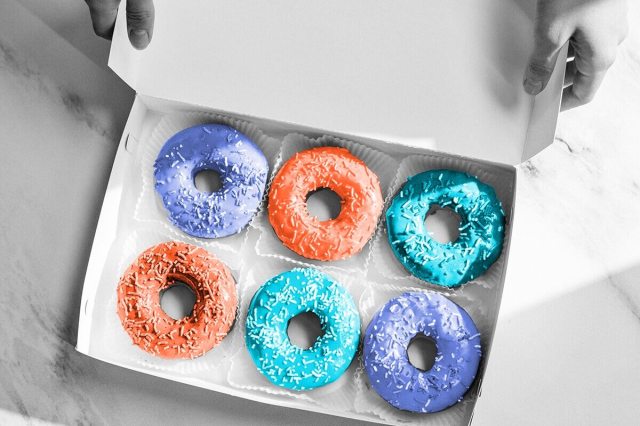
Cheesecake
New York City may be the world’s cheesecake capital, but the classic delight was actually created and shared thousands of years before the city’s founding. Originating with the ancient Greeks, early cheesecake was constructed from cheese that had been beaten until smooth and then blended with honey and flour. The crustless delight was served at special events, weddings, and even the first Olympic Games in 776 BCE.
But like any food that has transcended the centuries, the cheesecake morphed into the dessert we know today only slowly. By 160 BCE a newer version emerged with a separately baked crust, and an English recipe from 1390 blended sugar and dried elderflowers with cheese curds before baking the entire dish in a pie shell. When mass-produced cream cheese emerged in the 1870s, cheesecake recipes underwent another change. By the 1930s, New York bakeries had fully adopted the use of a cream cheese and sour cream base paired with a Graham cracker crust — creating the cheesecake we enjoy today.

Ice Cream
Ice cream may seem like a modern culinary invention considering its need for refrigeration, but food historians believe it appeared sometime within China’s Tang Dynasty, between 618 and 907 CE. Early ice cream blended goat, buffalo, or cow milk with flour and camphor harvested from evergreen trees, and it reached its creamy state after being plunged into ice pools. Cultures throughout Asia and Europe made similar frozen treats; Arab chefs created fruit sherbets during the Middle Ages, and sugary, milk-infused ice drinks became known as the first Italian sorbettos during the mid-1600s.
By the time ice cream reached North America in the 1700s, similar treats such as gelato had been popular in Italy and France for decades. But upgrades to icehouse technology in the 1800s allowed the American masses to finally enjoy ice cream more regularly. That same century saw a deluge of related innovations. Paper companies produced foldable “ice cream satchels” complete with wire handles for easily transporting the cold confection, and in 1897, Black inventor Alfred L. Cralle patented the Ice Cream Mold and Disher — the original ice cream scoop (from which he never made any money). And while waffle-style ice cream cones likely existed before the 20th century, the 1904 World’s Fair in St. Louis was so successful at popularizing the edible containers that it’s often credited as the site of their invention.

Doughnuts
Whether you enjoy them for breakfast or as a workday snack, doughnuts have become an iconic treat. World War I catapulted doughnuts to the front of our taste buds, but the circular sweets are actually much older. Archaeologists have unearthed fossilized remnants of prehistoric doughnuts from Indigenous communities in North America, while ancient Romans and Greeks paired fried dough with sweet and savory sauces. A plethora of fritters and fried pastries spread throughout Europe in the Middle Ages before early Dutch settlers brought them to the American colonies under the name “olykoeks,” describing how they were cooked in oil.
By 1750, the first American doughnut recipe was published, allowing cooks to create the desserts at home. But it wasn’t until World War I that doughnut popularity skyrocketed; the Salvation Army’s volunteer “doughnut girls” cooked and distributed the fried rings along trenches and frontlines to homesick soldiers. Shortly after the war’s end, the first doughnut machine popped up in New York City, cementing the dessert as a culinary mainstay.
More Interesting Reads

Jell-O
Gelatin-based foods have a long, unsavory history. First emerging in medieval Europe, wiggly foods were hard to come by unless you were nobility. That’s because early gelatin dishes were based on livestock bone collagen; boiling the bones to extract the substance took days of labor-intensive work. Hours of boiling, straining, and mixing with other ingredients required a large kitchen staff, making gelatin dishes a status symbol for upper-class diners.
Fast forward hundreds of years to 1845, when inventor Peter Cooper (who also created America’s first steam locomotive) crafted the first gelatin powder, which required little time to set after being mixed with just hot water. Cooper’s “portable gelatin” wasn’t a big hit, and the patent was sold to Pearle and May Wait, owners of a cough syrup and laxative company. The Waits added fruit syrups to the powdered gelatin, launching Jell-O as a jiggly dessert product before selling off the brand in 1899. With the help of magazine ads and radio jingles, the confection became a household name, its popularity rising in the 1920s and remaining a household name for decades to follow.

Pumpkin Pie
While apple pie may have misappropriated origins (the first recipe appeared in England around 1381, not the U.S.), pumpkin pie deserves more credit as a purely American dessert. The spiced autumnal pie that now inspires countless fall desserts and drinks was concocted by early English colonists who encountered native pumpkins for the first time. Accounts from the mid-1600s suggest that newcomers to young America were reliant on pumpkins, brewing them in ale and baking them into pies. Because of their easy-to-grow nature, pumpkins became popular throughout Europe, where countless recipes for the baked squash pies directed chefs to boil pumpkin flesh in milk or mix pumpkin puree with baked apples.
Modern pumpkin pie construction became significantly less laborious around the 1920s, when Libby’s brand launched its first canned pumpkin puree. Most cooks today continue to opt for the store-bought ingredient, though pie purists may just opt to roast their own pumpkins, considering commercial purees actually consist of a sweeter, butternut-like squash. Pumpkin pie may be seasonal, but the tradition of adding your own flair is what keeps it around from year to year — just like every other popular dessert.











